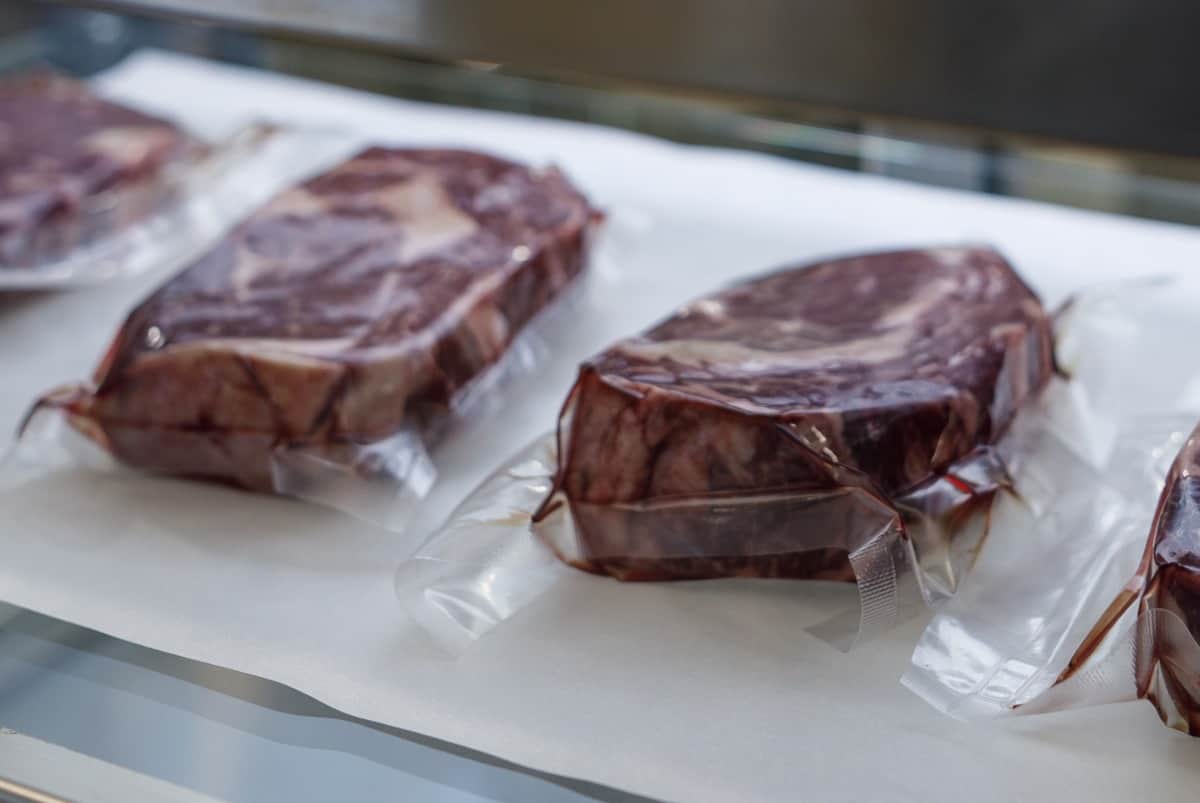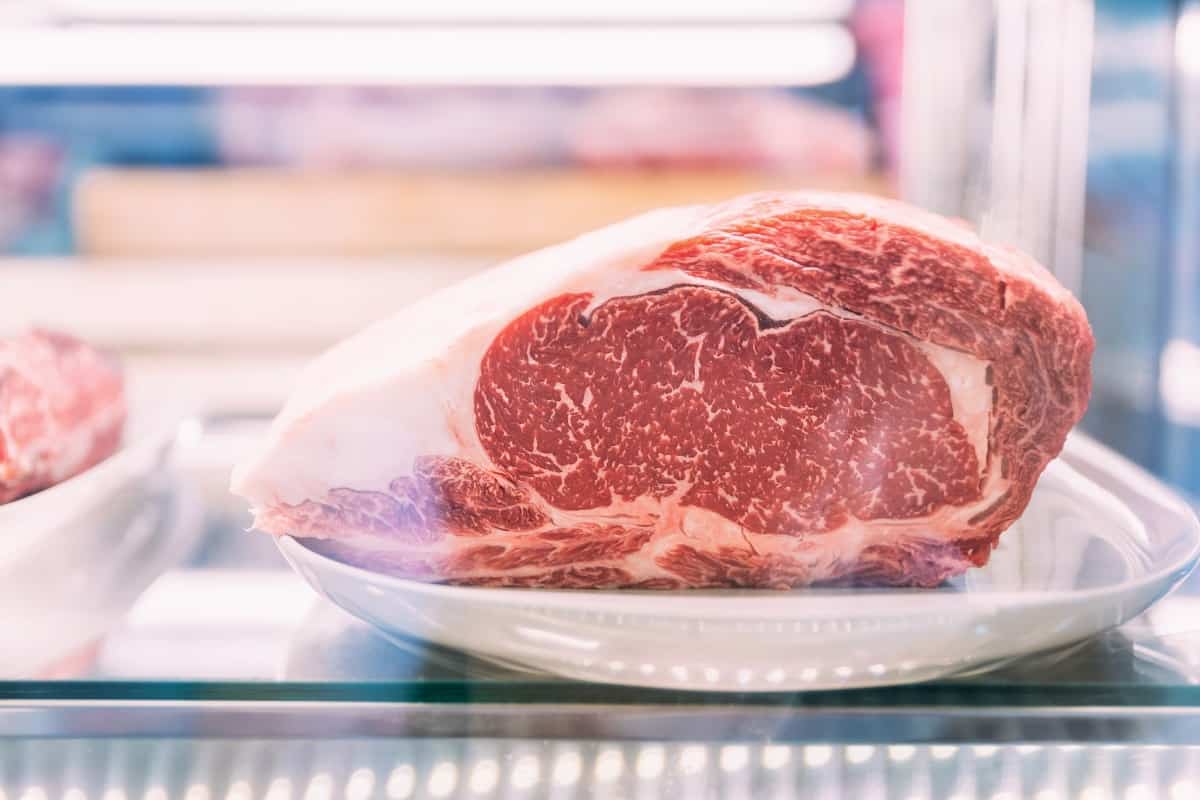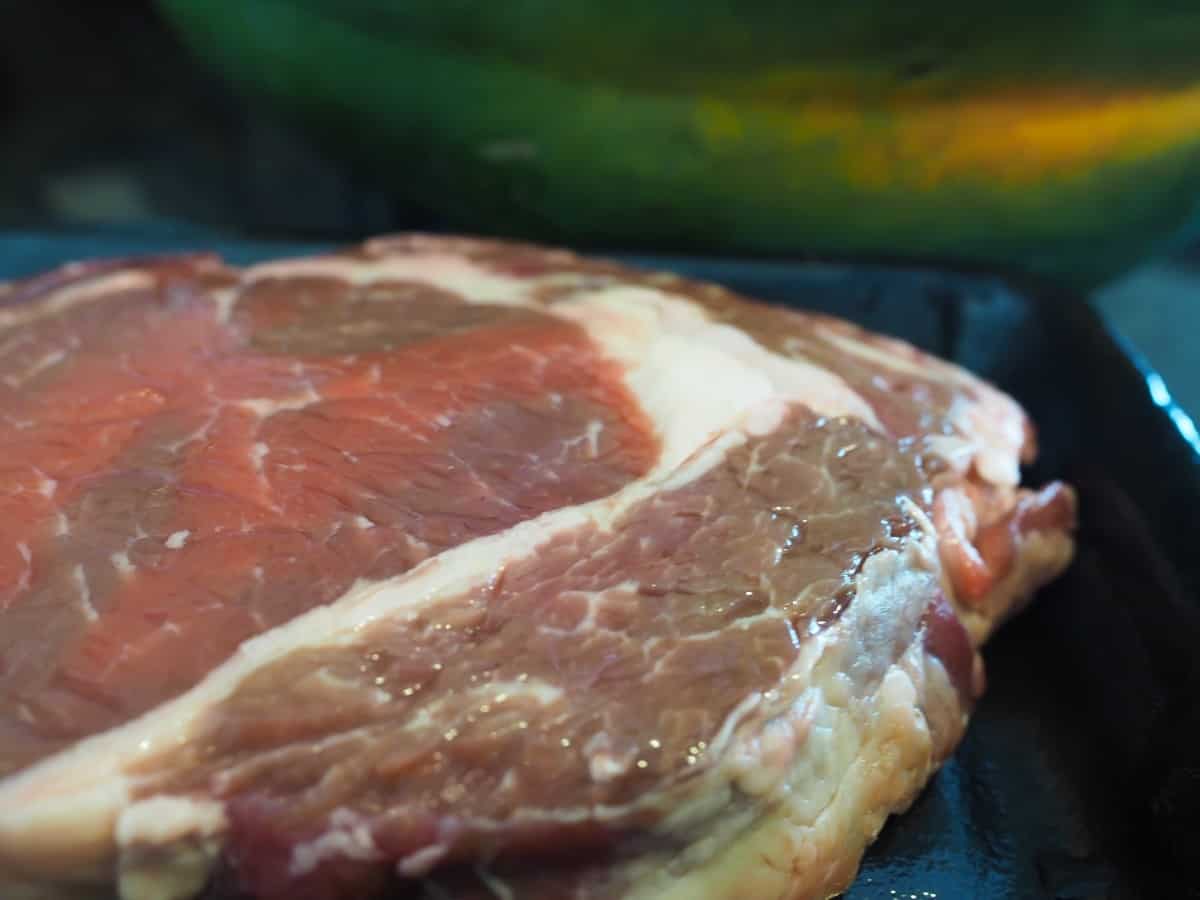How Long Can I Keep Raw Beef in the Fridge
If you're planning to buy steak and leave it in the fridge until you're ready to cook it, it's essential to know how long it can safely wait.
You're in the right place.
Here we'll cover those mysterious "Sell-by" and "use-by" dates stamped on food packaging and whether they directly relate to when steak goes bad. We'll look at how long steak can stay in the fridge, both raw and defrosted, and whether how it's packaged makes any difference.
For a bit of science, we'll explore what actually happens to a steak as it goes bad, and why that's a concern. And, since we hate to waste anything needlessly, we'll look at what — if anything — you can do with steak that's gone off.
Now, for a nice break with internet tradition, let's get to the heart of the matter straight away!
Contents (Jump to Topic)
- 1 Bottom Line up Front
- 2 Difference Between Sell-by Date and Use-By Date?
- 3 How Long is Steak Good for After the Sell-By Date?
- 4 Should You Stick to the Use-By Date?
- 5 How Long Can Raw Steak Stay in the Fridge?
- 5.1 If Vacuum Sealed
- 5.2 If Cling Film Wrapped
- 5.3 If Bought from the Butcher's Counter
- 6 How Long Can Thawed Steak Stay in the Fridge?
- 7 Place Raw or Thawing Steak on the Bottom Shelf
- 8 What Happens When Steak Goes Bad?
- 8.1 What Happens on a Chemical Level?
- 8.2 What Happens on a Food Safety Level?
- 9 How to Tell if Steak is Bad?
- 10 What Can You do With Spoiled Steak?
- 11 Final Thoughts
Bottom Line up Front
If you ask the USDA (and you should; they know their stuff), uncooked steak is good for between 3 to 5 days in a refrigerator, no matter how it's wrapped.
Practically speaking, you'll note variations based on what you've wrapped your meat in. Here's a chart to illustrate.
| Type of Wrap | Potential to Stay Fresh |
|---|---|
| Butcher paper | 3–5 days |
| Plastic wrap (including styrofoam tray/cellophane combo typical of grocery stores) | 3–5 days |
| Vacuum sealed | Up to 10 days |
Difference Between Sell-by Date and Use-By Date?
If your eyes (or your prescription) are strong enough to make them out, you'll note the "Sell-by" and/or the "use-by" date on your meat packaging. But what are they, and what's the difference?
According to the USDA, the "Sell-by" date is strictly for the retailer. It's there to help them manage their inventory to move out older products. A product past its "Sell-by" date is not necessarily unsafe to consume.
Interestingly, the "use-by" date isn't a safety date, either. Instead, it's the estimated point at which the product is at its peak; past that date, there may be a degradation in quality that could affect the flavor and other characteristics. So, a steak past the "use-by" date may be perfectly safe to cook and eat; it just may not taste as good as it might have.
How Long is Steak Good for After the Sell-By Date?
Assuming you've done nothing more than bringing your raw, packaged steak home and plonk it in the fridge, it's good to go for 3 to 5 days after the sell-by date. And you don't have to take just my word for it; the USDA will back me up on this.
At that time, you either have to cook the steak or seal it up for the freezer and save it for a later date.
Interestingly, sell-by dates are not mandated by law in the United States, so your grocer or butcher may not necessarily provide them on their packaging.
Should You Stick to the Use-By Date?
use-by dates are also not required by the government. But, they're handy for consumers because they tell us when we should use food by for optimal flavor and nutrition.
If you miss the use-by date on your steak by a day or two, you're almost certainly in no danger of it having spoiled, assuming it was properly sealed when it went into the fridge. You might notice a difference in flavor intensity, but I doubt it. You can always compensate with extra seasoning or a sauce of some kind.
Before going ahead and cooking that steak past its use-by date, though, check to make sure it's still good. Scroll down for more on that topic.
Interestingly, we often refer to use-by dates as "Expiration" dates. This is a misnomer; an expiration date is an entirely different thing. They aren't required on most food products in most jurisdictions, but some states require them on meat and dairy products.
In Canada, they're required on baby formula, nutritional supplements, and a few other niche items in the health food category.
How Long Can Raw Steak Stay in the Fridge?

If somehow you can resist the temptation to grill it and eat it immediately, the straight answer here is three to five days — that's the answer from the USDA, and they're more concerned with your health than with selling meat.
This answer assumes two things:
- Your steak is wrapped properly
- It's stored below 40 °F, the low point of the so-called "Danger Zone" for bacteria growth
Most bacteria thrive between 40 °F and 140 °F. Keeping your uncooked steak below 40 °F keeps bacteria in check, but won't eliminate them or prevent spoilage indefinitely.
How well and in what material your steak is wrapped can impact whether you're at the upper or lower end of the three to five day range. No matter how it's wrapped, though, you should always carefully inspect raw meat that's been stored before you cook it.
Here's a look at the three usual suspects for steak packaging.
If Vacuum Sealed
According to the USDA, vacuum sealing doesn't make any difference. According to companies that sell vacuum-sealed meat and vacuum sealing systems, it does.
Claims for vacuum-sealed raw steak range from a week to as many as 10 days.
Let me make it very clear: we do not suggest ignoring the USDA's advice. But, you can undoubtedly expect to hit the upper end of the range when you exclude any exposure to oxygen, at the very least.
If Cling Film Wrapped
Steak often comes from the grocery store on those flimsy foam trays and all wrapped in clear plastic. In theory, they should be as close to airtight as makes no difference, if not wholly anaerobic (total absence of oxygen – you get this with vacuum sealing, during which the air is sucked out).
But, the plastic is thin and easily torn during transportation from the store or transfer into the fridge. So, while you might get the full five days out of this method, I expect the average is closer to the low end.
If Bought from the Butcher's Counter
Done properly, butcher paper can be wrapped up as tight as plastic. Done improperly, you might as well let your raw steak sit naked on a plate.
Assuming you've gone to the trouble of finding a quality butcher because you love steak, there's no reason your paper-wrapped steak won't be good as new for the full five days.
How Long Can Thawed Steak Stay in the Fridge?

If you defrost your steak in the fridge, at no point will it ever be in the "danger zone" of 40 °F and 140 °F, unless something is wrong with your refrigerator. That means it's perfectly safe for as long as it takes to thaw. Once thawed, use your steak within 3 to 5 days for safe consumption.
There are other ways to defrost a steak, mind you. Whether or not you can refreeze a steak after defrosting depends on whether the steak ever got into the "danger zone" and for how long.
Our best advice is to cook your thawed steak ASAP for the best results. Refreezing thawed meat, while generally safe, can significantly impact the quality.
For details on de-icing, check out our article, How to Defrost steak.
Place Raw or Thawing Steak on the Bottom Shelf
When we handle raw meat, we must always be aware of the risk of cross-contamination.
Place your uncooked or thawing steak as low in the fridge as possible to avoid any fluid that might escape from the packaging getting on other food. That way, anything that drips out will pool at the bottom.
Wipe up any rogue juices carefully, and use anti-bacterial cleaner to leave the area safe for other food.
What Happens When Steak Goes Bad?

Ready for a science lesson?
Let's take a quick look at putrefaction — defined by Merriam-Webster as "the decomposition of organic matter" — and what's really going on in and on that steak of yours when it gets past the point of safe consumption.
What Happens on a Chemical Level?
Most of what happens to steak as it goes bad is caused by microorganisms living in and on the meat, including bacteria, yeast, and mold. Most of these are introduced during the butchering and packaging processes, and there's next to nothing you can do about it.
Exposure to oxygen and even light encourages microorganisms to grow. As a result, they begin to produce enzymes that go to work, destroying your beautiful steak.
If you really let your meat go bad, it will start to rot. Rotting meat produces some unpleasant compounds, including ammonia and the disgustingly named cadaverine and putrescine. Proteins and amino acids breaking down release them, and they're most notable for their bad smells. So if you catch a whiff of ammonia (it smells like sweat or urine) when you unwrap your raw steak, don't eat it.
What Happens on a Food Safety Level?
In and of itself, rotting meat may not be harmful. In fact, dry-aging meat is sometimes called "controlled rot." Many cultures deliberately allow meat to rot before eating to encourage certain flavors.
However, all those molds and bacteria may be very harmful. Food poisoning is a very real possibility with eating steak that's bad, thanks to nasty little pathogens like E.coli, salmonella, and staphylococcus.
Potential outcomes from eating bad steak range from feeling sick to your stomach to a very unpleasant death.
How to Tell if Steak is Bad?

No one wants to tuck in to a nasty steak that's gone off. At best, it'll taste unpleasant. At worst, it could make you very sick; in extreme cases, food poisoning can be fatal. Fortunately, there are many ways to determine if a steak has passed its prime.
Your senses are your best guide when it comes to telling if a steak is bad. You may notice peculiarities in smell, appearance, and the way the surface feels. More obviously, the use-by date is a reasonable guideline.
For an in-depth look, click over to our comprehensive guide on How to Tell if Steak is Bad, Gone off, or Spoiled.
What Can You do With Spoiled Steak?
You might think it's possible to just cook the bejeezus out of a spoiled steak, and it'll be ok. Unfortunately, some pathogens you just can't kill, no matter how hot you cook them.
And don't think that your dog's stronger stomach can handle it, either; whatever is likely to make you sick will probably have the same effect on your pooch.
Unless you happen to own a vulture, hyena, Komodo dragon, or another carrion-eating animal, the best thing to do with rotten or spoiled steak is throw it in the garbage.
If you live somewhere with curbside organic waste pick-up, go ahead and deposit it there. But, don't put spoiled meat in your garden composter; it may attract scavenging animals, and it could turn your pile into a breeding ground for bacteria.
Final Thoughts
Remember — though we often communicate in a light-hearted manner around here, food safety is no joke.
Always inspect your raw meat before cooking and handle it with care. Keep raw meat away from other food, wash your hands immediately after handling raw meat, and avoid cross-contamination from plates and utensils.
And never, ever take chances with steak that might be bad. It's just not worth the risk.
So, be smart, be safe, and enjoy excellent steak every time! Cheers, all, and thanks for reading.
jessopscrepativen1988.blogspot.com
Source: https://www.foodfirefriends.com/how-long-can-raw-steak-stay-in-fridge/
0 Response to "How Long Can I Keep Raw Beef in the Fridge"
Post a Comment